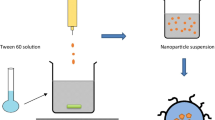Abstract
Purpose. To determine the feasibility of using wet milling technology to formulate poorly water soluble zinc-insulin as a stable, biologically active, nanoparticulate dispersion.
Methods. The feasibility of formulating zinc-insulin as a nanoparticulate dispersion using wet milling technology was studied. An insulin nanoparticulate formulation was reproducibly obtained after milling zinc-insulin in the presence of F68, sodium deoxycholate and water at neutral pH. The physical and chemical properties of these peptide particles were studied using electron microscopy, laser light scattering, HPLC and SDS-PAGE. To verify efficacy, hyperglycemic rats were dosed subcutaneously and intraduodenally with nanoparticles or solubilized insulin. Glucose and insulin levels were monitored on blood samples collected throughout the study.
Results. Zn-insulin (mean size = 16.162 μm) was processed using milling technology to form an aqueous-based nanoparticle dispersion with a mean particle size of less than 0.150 μm. The formulation was homogeneous and exhibited a unimodal particle size distribution profile using laser light diffraction techniques. Insulin, processed as a peptide-particle dispersion, was shown to be comparable to unprocessed powder using HPLC and SDS-PAGE. In addition, HPLC analyses performed on samples, heat-treated at 70 °C for 100 minutes, demonstrate that under conditions which effect the solubilized peptide, formulated as a peptide-particle dispersion, insulin was chemically stable. Also, when stored refrigerated, the insulin dispersion was chemically and physically stable. Finally, peptide particles of insulin, dosed subcutaneously and intraduodenally, were effective at lowering blood glucose levels of hyperglycemic rats.
Conclusion. Water insoluble Zn-insulin can be formulated as a stable, biologically active nanometer-sized peptide particle dispersion using wet media milling technology.
Similar content being viewed by others
REFERENCES
D. R. Owens, B. Zinman, and G. B. Bolli. Insulins today and beyond. Lancet 358:739-746 (2001).
A. Saul. Search for a better method of insulin delivery. Drug Topics 145:2S-3S (2001).
V. Agarwal and M. A. Khan. Current status of the oral delivery of insulin. Pharmaceutical Tech. (October):76-88 (2001).
M. J. Taylor. Improving insulin therapy. Drug Deliver. Sys. Sci 1:101-105.
A. Dove. Seeking sweet relief for diabetes. Nat. Biotech. 20:977-981 (2002).
F. P. Kennedy. Recent developments in insulin delivery techniques: current status and future potential. Drugs 42:213-227 (1991).
L. Heinemann, T. Heise, and A. Pfuetzner. Alternate routes of administration as an approach to improve insulin therapy: Update on dermal, oral, nasal and pulmonary insulin delivery. Cur. Pharm. Design 7:1327-1351 (2001).
J. P. Richards, M. P. Stickelmeyer, D. B. Flora, R. E. Chance, B. H. Frank, and M. R. DeFelippis. Self-association properties of monomeric insulin analogs under formulation conditions. Pharm. Res. 15:1434-1441 (1998).
S. Sato, C. D. Ebert, and S. W. Kim. Prevention of insulin self-association and surface adsorption. J. Pharm. Sci. 72:228-232 (1983).
S. Hvidt. Insulin association in neutral solutions studied by light scattering. Biophys. Chem. 39:205-213 (1991).
F-Y. Liu, D. O. Kildsig, and A. K. Mitra. Insulin aggregation in aqueous media and its effects on alpha-chymotrypsin-mediated proteolytic degradation. Pharm. Res. 8:925-929 (1991).
U. Hassiepen, M. Federwisch, T. Mulders, and A. Wollmer. The lifetime of insulin hexamers. Biophys. J. 77:1638-1654 (1999).
E. Merisko-Liversidge, G. G. Liversidge, and E. R. Cooper. Nanosizing: a formulation approach for poorly water soluble compounds. Eur. J. Pharm. Sci. 18:113-120 (2003).
R. H. Muller, C. Jacobs, and O. Kayser. Nanosuspensions as particulate drug formulations in therapy: rationale for development and what we can expect for the future. Adv. Drug Deliv. Rev. 47:3-19 (2001).
G. G. Liversidge, K. C. Cundy, J. F. Bishop, and D. A. Czekai. Surface modified drug nanoparticles. U.S. Patent 5 145 684, 1992.
G. G. Liversidge and K. C. Cundy. Particle size reduction for improvement of oral bioavailability of hydrophobic drugs: I. Absolute oral bioavailability of nanocrystalline danazol in beagle dogs. Int. J. Pharm. 125:91-97 (1995).
E. Merisko-Liversidge, P. Sarpodar, J. Bruno, S. Hajj, L. Wei, N. Peltier, J. M. Shaw, L. Pugh, J. Jones, T. Corbett, E. R. Cooper, and G. G. Liversidge. Formulation and antitumor activity evaluation of nanocrystalline suspensions of poorly soluble anticancer drugs. Pharm. Res. 13:272-278 (1996).
J. Rivier and R. McClintock. Reversed-phase high-performance liquid chromatography of insulins from different species. J. Chromat. 268:112-119 (1983).
B. V. Fisher and D. Smith. HPLC as a replacement for the animal response assays for insulin. J. Pharm. Biomed. Anal. 4:377-387 (1986).
M. Radtke. Pure drug nanoparticles for the formulation of poorly soluble drugs. New Drugs 3:62-68 (2001).
J. G. Still. Development of oral insulin: progress and current status. Diabetes-Metabolism Res. Rev. 18:S29-S37 (2002).
Author information
Authors and Affiliations
Rights and permissions
About this article
Cite this article
Merisko-Liversidge, E., McGurk, S.L. & Liversidge, G.G. Insulin Nanoparticles: A Novel Formulation Approach for Poorly Water Soluble Zn-Insulin. Pharm Res 21, 1545–1553 (2004). https://doi.org/10.1023/B:PHAM.0000041446.14569.e2
Issue Date:
DOI: https://doi.org/10.1023/B:PHAM.0000041446.14569.e2




